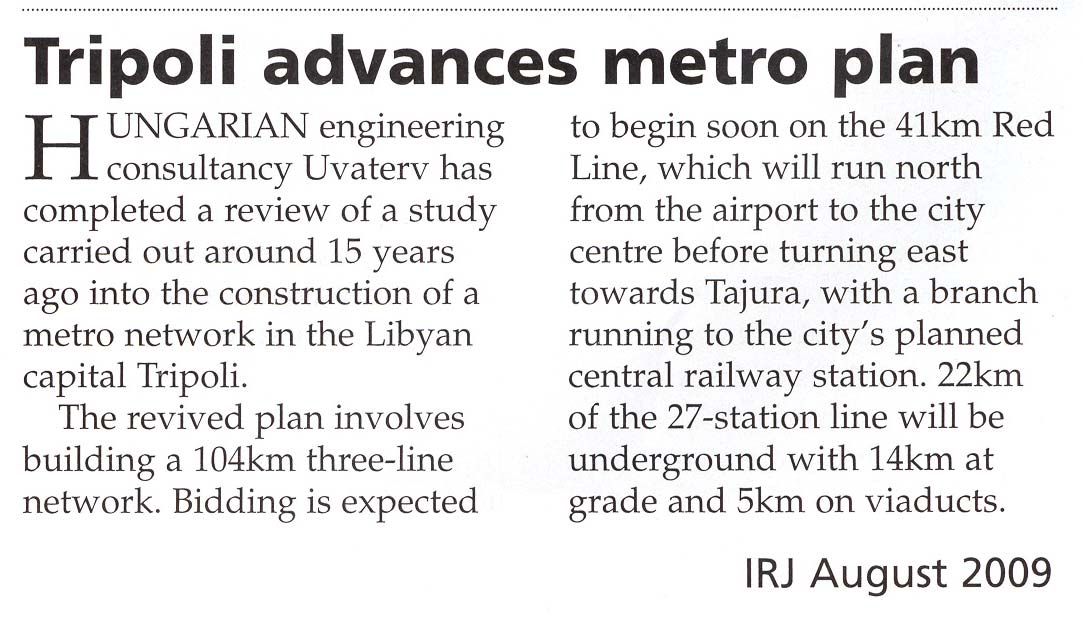| Company Portrait | Quality System | Organigram |
| Board of Directors | Memberships |
Contact |
| Management | History |
Maps |
Design of metro lines and tunnels



Location:
Principal:RAILROAD PROJECT EXECUTION AND MANAGEMENT BOARD P.O. Box: 82376 Swani Street Tripoli Libya
Year:2009
Revenue:
Description of the works:
Regarding the realization of the Tripoli metro network, backbone of the public transport system of the capital, two design documentations have been completed up to now:
- in the 1980-ies, the preliminary study entitled „Corrected final study of the Tripoli Metro”, and
- in 2007-2008 the revised version of the above study, entitled „Revised Study of the Tripoli metro”, which is an updated version of the original study, taking into account the most up-to-date technical and operation organizational aspects and results of the recent years.
The main technical parameters characterizing the improved Tripoli metro network are as follows:
- Number of the metro lines: 3
- Operation length of the metro lines: (underground/surface/elevated)
o Line „A” (green) : 29,60 km /0,0 km /0,0 km
o Line „B” (red): 32,87 km /14,53 km /4,88 km
o Line „C” (blue) : 22,33 km /0,0 km /0,0 km- Total operation length of the entire network: 104,21 km
- Total length of the network including the connecting tunnels: ~106 km
- Number of stations: (underground/surface/elevated)
o Line „A”: 22/0/0
o Line „B”: 23/3/5
o Line „C”: 19/0/0
- Total number of stations: 72
- Number of workshops: 4 (one workshop by line and one central workshop)
- Vehicle park: at the final stage of realization: 70 (single room trains provided with air conditioning system, composed of 4 cars 20m long each)
- Shortest proposed headway: 3,5 min
- Train traffic: automatic train control (ATC), operating without engine driver at the final stage of realization.
- Operation technology: the supervisory system organized in local (station), line and central (network) subdivisions operate the safety, traffic, power supply and technical dispatcher system.
- Electronic supervisory and data processing system (SCADA = Supervisory Control and Data Acquisition).
- Passenger traffic: computerized, chip card system access (entrance and exit) control. Traffic with escalators and elevators. Operation of exhaustive, many-sided passenger information system (visible, audible and mechanically perceptible)
- Safety of passengers: High-level prevention (application of platform screen doors), and effective reduction of consequences.
- Fire protection: operation of multi level system (prevention, detection, signaling, evacuation and extinguishing) Application newest developed equipments, e.g. water mist extinguishers, and high capacity heat and smoke removal system.
- Power supply: 750 V DC; lower contact type third rail supply for the train traffic, and 3x400/230V AC for the auxiliary consumers supply. The major part of the 0.4kV consumers are provided with diesel or battery reserve supply as well.
- Telecommunication: the network includes all the elements of the modern telecommunication systems, with particular regard of the following ones:
o Technology related transmission technique system
o Exchange phone system and transmission technique
o Dispatcher phone system
o Radio phone system
o Central clock system
o Emergency call system (station and vehicle)
o Public addressing system (station and vehicle)
o CCTV system
o Textual passenger information system (variable message display boards)
- Railway signaling system: The signaling system and the train control system comprises three equipment groups:
o Signaling system realized with electronic and IT devices;
o Train control in strict cooperation/relation with the signaling system, provided with ATC (ATO/ATP = Automatic Train Operator/Automatic Train Protection) subsystems.
o The operation interface of the system is of ATS type (Automatic Train Supervisor), the control center of which has the power of intervention both on the signaling system and the train control, in automatic and manual modes as well.- HVAC (Heating, Ventilating and Air Conditioning)
o Main ventilation system dimensioned for heat- and smoke removal, operating in winter/summer and heat- and smoke removal mode.
o Separate station ventilation system for the stations by installing platform screen walls detaching the running tunnels from the air space of the stations. The stations and trains are entirely air-conditioned.
o Heat removal from the running tunnels and stations is ensured with central liquid cooler units, installed in-site.
- Sanitary Installation
o Water supply from the urban network
o Sewage disposal into the common urban sewerage network
o Fire protection by fire hydrants and water mist extinguisher system
- Connecting surface transport systems:
o Large bus network adapted to the execution phases of the metro system
o P+R system for ensuring the favorable interchange between the individual and the metro traffic
o Direct transfer connection to the railway line under construction, at the future main railway station
o Direct transfer connection to the air traffic at all future terminals of the international airport
- Environmental Protection
The implementation and the operation of the metro network meet the strictest requirements in the following fields:
o soil, groundwater, air and noise pollution
o solid waste treatment and protection against sand
o protection of the flora and fauna and the built environment
Name of contact officer: Eng. Abdullah Yousef Elmiladi, (Director of metro project)
Telephone number of contact officer: +218-91-313-99-33
Report on the project published in the International Railway Journal:
